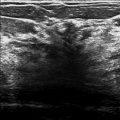Presentation and Presenting Images
A 78-year-old female with chronic obstructive pulmonary disease (COPD) presents for a chest computed tomogram (CT). She has a history of bilateral reduction mammoplasties.
89.1.1 Imaging Findings
The chest CT shows bilateral pleural effusions (arrows) and left nipple-areolar skin thickening and distortion (circle) in the left retroareolar region ( ▶ Fig. 89.1 and ▶ Fig. 89.2). These findings prompted mammographic evaluation ( ▶ Fig. 89.3, ▶ Fig. 89.4 and ▶ Fig. 89.5).
89.2 Key Images
( ▶ Fig. 89.3, ▶ Fig. 89.4, ▶ Fig. 89.5, ▶ Fig. 89.6, ▶ Fig. 89.7, ▶ Fig. 89.8, ▶ Fig. 89.9, ▶ Fig. 89.10, ▶ Fig. 89.11)
89.2.1 Breast Tissue Density
There are scattered areas of fibroglandular density.
89.2.2 Imaging Findings
The mammographic imaging of the left breast reveals a spiculated mass with associated linear heterogeneous calcifications (oval) in the retroareolar region. A radiopaque BB (broken arrow) marks the nipple in the lateromedial (LM) view ( ▶ Fig. 89.8). An abnormal lymph node (solid arrow) is seen in the low axilla on the mediolateral oblique (MLO) and LM views ( ▶ Fig. 89.7 and ▶ Fig. 89.8). Digital breast tomosynthesis (DBT) views help to delineate the linear orientation of the calcifications ( ▶ Fig. 89.9 and ▶ Fig. 89.10). The right breast (not shown) shows postreduction changes and no suspicious findings.
89.3 Diagnostic Images
( ▶ Fig. 89.11 and ▶ Fig. 89.12)
89.3.1 Imaging Findings
These spot-magnification views of the retroareolar calcifications noted on the DBT reveal pleomorphic calcifications in a linear orientation ( ▶ Fig. 89.11 and ▶ Fig. 89.12). These are not in the skin.
89.4 BI-RADS Classification and Action
Category 5: Highly suggestive of malignancy
89.5 Differential Diagnosis
Breast cancer (in situ and invasive ductal carcinoma): A spiculated mass with pleomorphic calcifications and axillary adenopathy are all suspicious findings for malignancy.
Post–reduction-mammoplasty changes: The patient has had bilateral reduction mammoplasties, but the current imaging findings show the breasts as asymmetrical. While asymmetrical findings are possible, in this case the findings are suspicious for malignancy and warrant biopsy.
Fibrocystic changes: The morphology (pleomorphic) and orientation (linear) of the calcifications are inconsistent with fibrocystic changes.
89.6 Essential Facts
The morphology (pleomorphic) and orientation (linear) of the calcifications are inconsistent with fibrocystic changes.
Chest CT can identify incidental breast lesions. Moyle and colleagues (2010) found that 30% of the incidental breast lesions that were detected on CT in their study were unsuspected breast cancers, particularly the spiculated masses.
Indeterminate and suspicious CT-identified breast lesions should be further evaluated with mammography.
89.7 Management and Digital Breast Tomosynthesis Principles
Because DBT images present with reduced tissue overlap and structural noise, indeterminate and suspicious lesions are seen better, which leads to improved reader confidence.
Two-view tomosynthesis imaging is required. Orthogonal reconstructions cannot be generated from DBT as from CT or magnetic resonance imaging (MRI). Elongated, planar, or nonspherical etiologies may be better seen in one view than another on DBT.
Magnification cannot be performed with DBT. Thus, for optimal breast imaging, tomosynthesis systems must support both conventional mammography and DBT.
Tomosynthesis-directed stereotactic biopsy may be used to biopsy calcifications, masses, and/or architectural distortions.
89.8 Further Reading
[1] Harish MG, Konda SD, MacMahon H, Newstead GM. Breast lesions incidentally detected with CT: what the general radiologist needs to know. Radiographics. 2007; 27 Suppl 1: S37‐S51 PubMed
[2] Moyle P, Sonoda L, Britton P, Sinnatamby R. Incidental breast lesions detected on CT: what is their significance? Br J Radiol. 2010; 83(987): 233‐240 PubMed
[3] Muir TM, Tresham J, Fritschi L, Wylie E. Screening for breast cancer post reduction mammoplasty. Clin Radiol. 2010; 65(3): 198‐205 PubMed

Fig. 89.1 Axial noncontrast computed tomogram (CT) of the chest.
Stay updated, free articles. Join our Telegram channel

Full access? Get Clinical Tree








